- Bill Heidig's Photos
- Background info
- More photos
- More photos
- Antenna design report
- Antenna Parameters
- Exmouth info
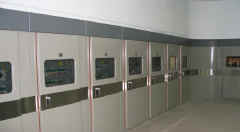
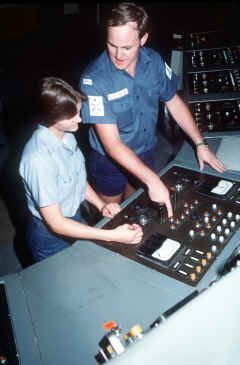
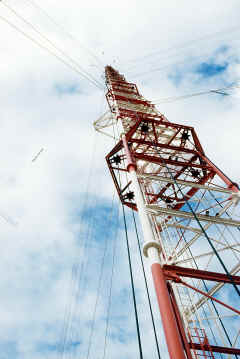
|
|||
AN/FRT-67 VLF Transmitter
|
|||
Leading Seaman Electronics Technician Wayne Nitschke of the
RAN and RM2 Linda Gibbon - 8/1/1989 |
AN/FRT-67 Helix Room |
Tower Zero - 8/1/1989
|
Bill Heidig's VLF Site Photos |
|||
== |
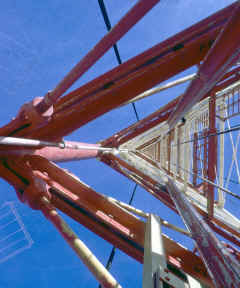
|
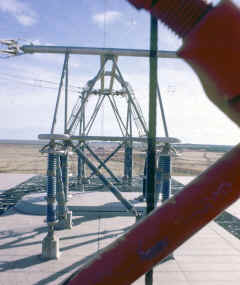
|

|
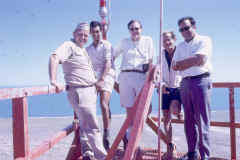
|
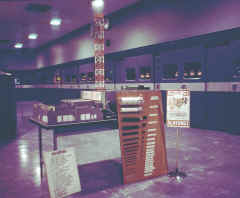
|
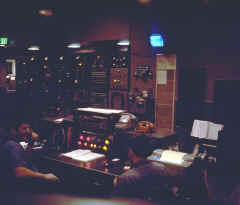
|
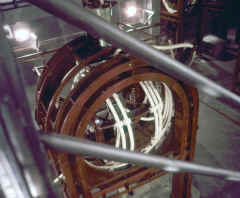
|
Naval Communication Station Harold E. Holt is arranged in three major areas, Areas "A", "B", and "C".
Area "A" is the northernmost tip of land on the peninsula known as North West Cape. Encompassing the entire VLF facility, it covers the area of 5,600 acres. It includes the VLF transmitter building, which in turn contains the transmitting equipment and helix rooms. The power plant, the main fuel facilities, the pier, and several salt water wells are also found in this area.
The two million watt VLF transmitter is a product of Continental Electronics Corporation of Dallas, Texas, and operates in the frequency range of 14-28.5 kilohertz.
Covering 1000 acres, the VLF antenna array is the largest in the world. The antennas themselves are large spider-webs of wire, supported like a tophat on thirteen steel towers. The towers serve no other purpose than to support this tophat arrangement. The center tower, Tower Zero, is the highest manmade structure in the Southern Hemisphere. It rises to an awesome height of 1,271 feet. The other towers spread out in two concentric rings around Tower Zero. The inner ring of towers is 1 195 feet high and the outer ring is 996 feet high. Buried in the ground beneath the antenna is 240 miles of bare copper wire which comprises the "ground mat".
The power plant located in area "A" is one of the largest presently operated by the U. S. Navy. It is made up of six diesel engine driven generators each possessing the capability to produce 3,000,000 watts of power. This creates a total plant capacity of 18,000,000 watts, enough to supply the electric needs for a city of 12,000 people. At present this plant is committed to provide the total power for areas "A" and "B".
Also located in area "A" is the pier which is designed to berth ships with a draft of up to 40 feet. This would include destroyers, cruisers, and most cargo vessels. It has the ability to withstand 30-foot waves, and features "float away" decking to relieve strain on the main structure during high seas. This pier functions as a receipt medium for fuel and supplies. Privately owned vehicles shipped from Oakland, California via Knutson Line vessels are brought directly to this pier. The pier is also a recreational assets, as excellent fishing is available from the pier area.
Area "B" is six miles south of Area "A". It incorporates both the station headquarters component and the high frequency transmitter site. Each building is either completely air-conditioned or dehumidified, depending upon the nature of its associated function. Area "B" contains the main Administration Building, the Fire Station and Security Building, Public Works Maintenance Shops, Supply Warehouse, Laundry and Dry Cleaning Plant, Commissary, Cold Storage and Main Galley/Mess Hall, four Enlisted Men's Barracks, CPO/EMClub, an Officers' Club, a Multi-purpose Recreation Building and Swimming Pool, Navy Exchange, Theater, Chapel, Dispensary, two eight-man Bachelor Officers' Quarters, various fiscal and disbursing facilities, a support services administration building, gymnasium, tennis courts, basketball courts, softball field, a baseball field and a multi-purpose hobby shop.
Also located in area "B" is the Communication Center. This is the hub of the station's communication/operational activities.
Between the main administration area and the town of Exmouth is the High Frequency Transmitter site. The High Frequency Transmitter Building houses 4 (?) transmitters. Many of these transmitters send on point-to-point circuits which terminate with such places as Guam, the Philippines, Ethiopia, and the Royal Australian Navy Communication Station in Canberra, Australia. These point-to-point circuits have the capability of 16 channels for instantaneous communications with activities locations listed above. Navy tactical circuits are employed with the U. S. Seventh Fleet. Additionally, various terminations are maintained with units in waters surrounding the continent of Australia. The mode of communicating includes CW (on-off keying), voice and teletype.
Area "C" is the main receiver site of the communication station and is located 37 miles south of area "B". Included in this facility is a Receiver/ Administration Building, Power Plant, Water Treatment Plant, and an above ground fresh (raw) water storage tank of 67,000 gallons capacity, and a 10,000 gallon tank for treated fresh water supply. Two fresh water wells are located about two miles northwest of the facilities center.
There is a 300-foot microwave tower which provides a link with the Communications Center. The Power Plant is comprised of four 175 KW diesel generators which not only provide power for the area "C" installation, but also provide the basic power for an Australian PMG (Post Master General) receiver site located to the south.
The main building houses high frequency receivers in the 2 to 30 Mhz band and one VLF receiver. These provide the necessary reception terminations for all of the point-to-point Navy tactical and merchant ship circuits. The main building is also fitted with a small dormitory and messing facility. These facilities are adequate to sustain watch personnel during times of emergency.
Up to this point we have considered the Naval Communication Harold E. Holt from a basically historical and physical perspective. However, in order to truly understand its purpose and value within the world-wide network of U. S. Defense Communications, one must reflect upon a few operational insights.
Operating Procedures
For the most part, only that message traffic required to serve the needs of this communications station will be originated or receipted for by this command. This station serves primarily as a relay station. Messages are picked up from the world-wide "pipeline" of Naval Communications by the high frequency receivers in area "C". From here the signal travels through a microwave link to the Communication Center in area "B".
The Communication Center acts as a sorting house for message traffic. Messages directed to this command will carry routing indicators which will cause them to terminate at the Communications Center. Those messages destined for ships and submarines will be relayed through the Communication Center to the High Frequency Transmitter in area "B" or to the Very Low Frequency Transmitter in area "A". From one of these points, it will be transmitted to those ships or submarines for which it is designated.
NAVAL COMMUNICATION STATION, HAROLD E. HOLT (VLFPAC)
The Navy has the special problem of providing reliable communications over vast areas of ocean. To do this, it employs very low frequency (VLF) radio facilities, since VLF transmission is most efficient for communications over great distances. Additionally VLF transmission permits radio communication with submarines submerged at considerable depths, a feature of incalculable importance given the missile submarine's strategic role. An important link in the VLF network is the Naval Communication Station Harold E. Holt, at North West Cape, Australia.
Planning for the Very Low Frequency Naval Communications Station, North West Cape, Australia (the name was changed to Naval Communication Station, Harold E. Holt on 14 September 1968) began during the late 1950s, when the Navy, recognizing the need for better communications coverage in the Indian Ocean and Southwest Pacific areas, began a search for a suitable station site. After a thorough investigation, North West Cape, Australia was selected in 1961.
The Command was made responsible for construction and an Officer in Charge of Construction was established in Perth in 1963. Ground was broken for the new project at North West Cape that same year.
The actual construction was a joint Australian-American effort and was carried out by contractors and sub-contractors of both nations. The station is located on 18,000 acres in a very remote section of the state of Western Australia. This site presented staggering logistical problems, located as it is 750 miles from Perth, the nearest city. Initially the only link between the site and Perth was a dusty, dirt road.
This gigantic facility was divided into three major areas.
Area "A", located at the extreme northern tip of the cape was known as the "Low Frequency Area." This area, 5,600 acres in size, contained the VLF transmitter facility consisting of the antenna and transmitter building. The antenna system dominated the area. It was composed of a complex of towers and antenna wire systems, resembling a six pointed star, approximately 8,400 feet in diameter. The elevated wires were supported at an average height of 900 feet by twelve towers arranged in a hexagonal pattern in two rows around a central thirteenth tower. This central tower was 1,296 feet high while the towers of the inner ring were 1,195 feet high and those of the outer ring were 996 feet high. At the time of its construction the central tower was the tallest structure in the southern hemisphere. Although the shortest, the outer ring towers were still taller than the Eiffel Tower. These outermost towers of the complex were 1.56 miles apart. More than six miles of steel guy wires, nearly two inches in diameter, safeguarded the aerial maze against hurricane-force winds.
Also located in the VLF transmitter area were the pier and harbor facilities, oil storage, and the main power plant which was capable of producing approximately 18,000 kilowatts of electrical energy.
The second area, which was designated the "Administration and High Frequency Transmitting Area," comprised approximately 3,000 acres and was located about seven miles south of the low frequency site, on the Coast of the Gulf of Exmouth. This site contained bachelor officer and bachelor enlisted quarters, a naval exchange and other support facilities. In addition this site housed high frequency transmitter buildings, associated antennas, a communications center, and administration, storage and maintenance buildings.
The third site, known as the "High Frequency Receiver Area," was about 9,500 acres in extent and was located 30 miles from the Administration and High Frequency Transmitter Area. This area contained a high frequency receiving building, an antenna, a small power plant and other necessary utilities.
The Command was responsible not only for the construction of base facilities, but also for the procurement and installation of the VLF transmitter and antenna. The Command's procurement responsibility also included design. Design of the transmitter and antenna system was done with the help of the Naval Electronics System Command. Construction was initially planned to take place in three increments over a three year period, with $30 million programmed for fiscal year 1965. The total cost was estimated at $70 million.
During the first two years, the VLF transmitter, the high frequency transmitting system and the administration, support and operations buildings, main power plant and pier were built. Because of high costs resulting from the remoteness of the site, as much work as possible was included in the initial bid package. To achieve this objective, lump sum contracting was used. Unique at this time, lump sum contracting would be used with great success during the Vietnam war construction effort.
The work was subdivided into components "A" and "B." The former contained items estimated to be worth 50 percent of the amount bid, and the latter the items still to be funded. The successful bidder was to commence work on "A" immediately, but upon "B" only when notified by the Command. The low bid for fiscal year 1963 construction was $34.8 million; the contract was awarded on 19 July 1963.
An interesting sidelight on this project was the construction of the town of Exmouth. The construction site was so remote that there were no living or support facilities for the construction workers and their families. As a joint venture, the Navy and the Australian government built a town at a point south of the administration and service area. This town, named "Exmouth," was completely planned and provided housing, stores, and schools for the construction personnel and their families. construction on the whole project came to a successful climax on 7 November 1966 when the first VLF signal was broadcast from North West cape.
BY PH2 DOUG CUNNINGHAM & J03 BOB COWAN - From "All Hands" April 1979
Yes, Virginia, there is a Harold E. Holt Naval Communication Station, but a lot of people don't know it exists. Late last year, for instance, two Holt athletes competed in the 14th Naval District's Flag Football Championships in Hawaii. Soon after arriving, they discovered none of their teammates had ever heard of a communication station in Western Australia. Fact is, most thought the duo were Royal Australian Navymen!
Named for a former prime minister of Australia, NAVCOMMSTA Harold E. Holt doesn't get much publicity. Located about 800 miles north of Perth on North West Cape, Holt's 450 Navy people and a contingent of Royal Australian Navymen (RAN) maintain and operate gear used to communicate with submarines. Communications are via Very Low Frequency (VLF) transmitters emitting radio waves capable of penetrating the ocean's surface and maintaining one-way contact with our nuclear-powered, ballistic missile subs-the world's most powerful deterrent force.
Although the station houses numerous high frequency transmitters for communicating with surface ships, these are secondary to its VLF equipment. Holt's antenna field, on the tip of the cape, covers nearly 1,000 acres-an area large enough to fit downtown Perth smack dab in the middle. It looks something like a Texas oilfield during boom times.
The center of attention amid 13 spindly towers is Tower Zero, at 1,271 feet the tallest structure in the Southern Hemisphere. Standing 21 feet higher than the main section of the Empire State Building, Tower Zero was built after an Australian-American agreement paved the way to establish the complex in 1963.
Today, the U.S. Navy enjoys a mutually beneficial relationship with the RAN. In 1974, Holt became a jointly manned communication station with each navy maintaining its own communications centers in the same building. U.S. transmitting equipment is shared by both countries, as are all other facilities making life on the barren cape possible.
Duty there begins when a Military Airlift Command or Australian commercial airliner lands at Learmonth Royal Australian Air Force Base, an airstrip less than 20 minutes from Harold E. Holt. (The airport, currently in a caretaker status, is capable of being converted to a full-time air force base on short notice.)
Even those who favor cape life from the start admit the area around Learmonth isn't exactly appealing. The landscape is rough and dry, and Australian bush flies swarm incessantly during summer when temperatures soar to an intolerable 120 degrees. Still, there are good points. Some say that parts of the terrain remind them of California's Imperial Valley. This illusion is due, in part, to the perseverance of Holt personnel in planting trees and flowering shrubs wherever they'll grow. Human landscaping efforts are supplemented by Nature's own additions-a scattering of sand dunes, shrubs, scrub patches of grass and small trees. Only a stone's throw from the Indian Ocean, the area is free of fog, smoke and big-city smells.
And then there is the wildlife. American Navy people expect to see kangaroos, wombats, koalas and other exotic beasts ...and they do, though, to see most of them, they have to travel far south of the cape. Kangaroos, however, abound on the cape and bounce around enough to be considered a major road hazard. Cape birds include various types of cockatoos and the emu, a giant second cousin of the ostrich which can't fly, but doesn't need to when it can run a mile in little more than a minute.
Before NAVCOMMSTA was established, the area's chief industry was sheep ranching. Of the two sheep ranches operating before November 1963, one is now a national park encompassing most of the cape. The other has "business as usual."
About seven miles south of the transmitter site lies the town of Exmouth. Administered by Australian officials under Australian law, Exmouth is a community of RAN and USN service people and immigrants from many European countries. In all, about 3,000 people live and work together on North West Cape, and Holt is the main employer. Due to easily established friendships and an outstanding sponsorship program, newcomers find themselves within the flow of cape life from the moment their sponsor introduces them to their Australian and American neighbors.
Exmouth isn't really a resort, but, with recreational facilities comparing favorably to those at any large stateside base, one wonders, "Why not?" Practically everyone is "into" fishing, diving, snorkeling, shelling and swimming. "I'm beginning to be a beach person myself," said Storekeeper Second Class Sonny Carlson. "I just bought some snorkeling gear and I may be using it quite a bit before 1 leave." Carlson and his wife describe their housing as "the best in the Navy" and they like their new home because "we really fit in."
Electronics Technician (Communications) Second Class John Powelka got interested in photography soon after arriving and now teaches an amateur photography class. He would have happily devoted most of his off-duty time to making photos, had he not tried snorkeling in the clear waters of Exmouth Gulf. "Now," he said, "though I still like photography, I think snorkeling might just be the next best thing."
Seaman Apprentice Quitsey Walden was ready for orders back to the states the minute she set foot on Aussie soil. "I was really depressed by what I saw," she said, "I thought the airstrip was Harold E. Holt and I didn't like it at all." Now, some months later, after getting to know the Exmouth citizenry, she says, "I like the easygoing way of life here and I love the weather and beaches."
Favorable water conditions and warm climate have not gone totally unnoticed by the rest of Australia-tourists visit Exmouth year-round and invariably head for the' beaches. Some come from as far away as Australia's "eastern states," some 2,500 miles away, a testimony to Exmouth's resort possibilities.
Australians, like their American cousins, love sports; volleyball, football, basketball and softball are Holt specialties. All sports, however, are not imported from the United States. Cricket, Australian rules football (in which players punt, kick and pass with their feet), soccer and field hockey-all traditional Aussie games --are played by Exmouth teams. Many U.S. sailors participate and find them "demanding and satisfying."
Twice a year, NAVCOMMSTA sends a varsity basketball team to compete in a basketball carnival at Geraldton, 425 miles south, and to the iron mining country northeast of the cape to play against Australian community teams. Fast friendships and mutual admiration quickly result as U.S. sailors discover, sometimes to their chagrin, that Australians really can play basketball.
Though the two navies compete vigorously on the courts and gridirons, they share each other's national holidays --one of which is the Australian commemoration of the Gallipoli Campaign. April 25, 1978, marked the 63rd anniversary of the landing of the Australian and New Zealand Army Corps ANZAC at Gallipoli during World War 1. Fighting for the British cause, the Corps' mission was to capture the Dardanelles, thereby enabling Allied forces to pass through the Suez Canal, capture Constantinople, and bring help to Russians on the Eastern Front.
It's been said that Australia came of age during that campaign in which 8.587 men were killed and 19,357 wounded. Though a military failure. the campaign's heroism won its participants world respect. The landing date became a national holiday for Australia and New Zealand -and a special day for Americans at Harold E. Holt. Each year, ANZAC Day is marked with solemn services, parades and regimental reunions. The 1978 commemoration began at dawn in Exmouth as two RAN men and a U.S. Navy man and woman raised the Australian and American flags and then lowered them to half mast in honor of the Gallipoli dead. Following two minutes of silence. a requiem and reveille, the traditional wreaths were laid.
A contingent of U.S. Navy enlisted men and an all-women marching unit marched in the mid-day parade through Exmouth, along with ANZAC veterans, a Royal Australian Navy unit. the town fire brigade and units of Scouts. Leading the parade and filling the countryside with the
melodious sounds of bagpipes was the Exmouth Pipe Band. Following commemorative addresses by Australian officials, the Americans blended their voices with those of countrymen in the singing of hymns and the Australian anthem. hymns such as these, daily cooperation on the job, competition in sports and social affairs soon dispel any noticeable differences in nationalities. Cape dwellers don't think of themselves as Americans or Australians; they don't think of North West Cape as the Naval Communication Station
- they're just people doing their jobs, living their lives, and the cape is home.